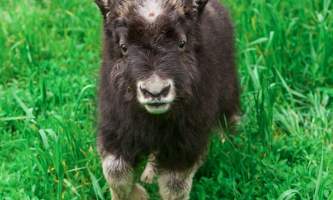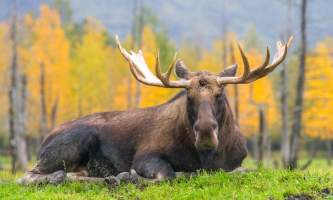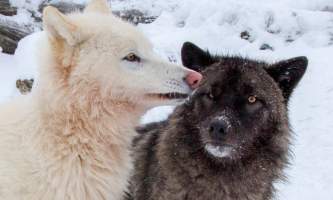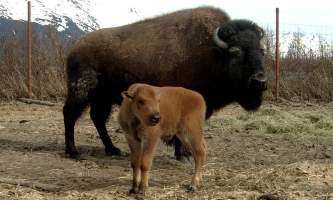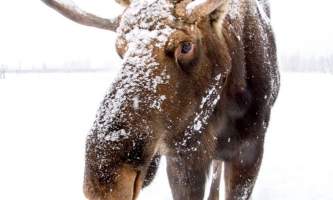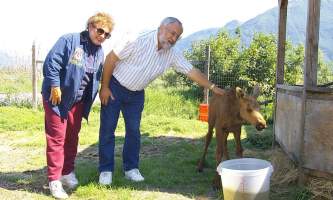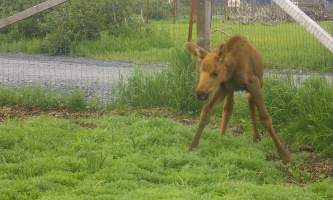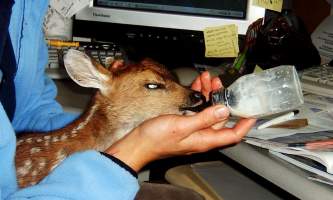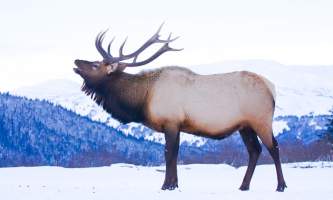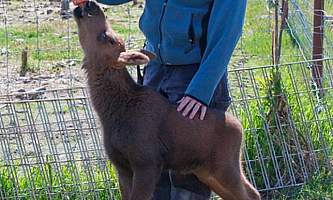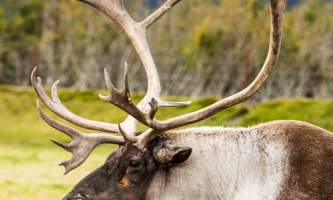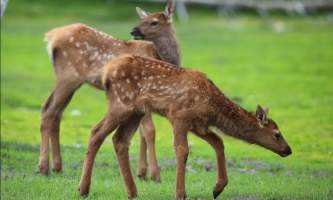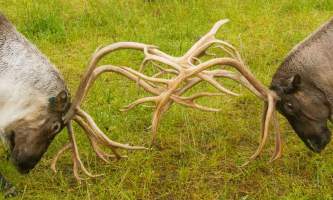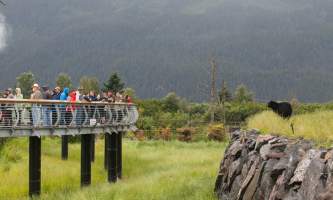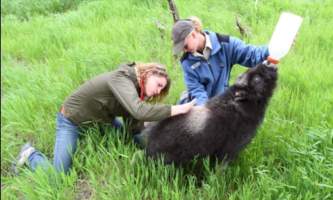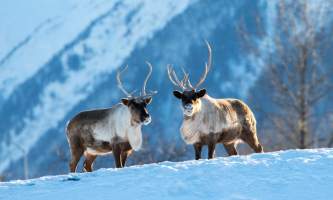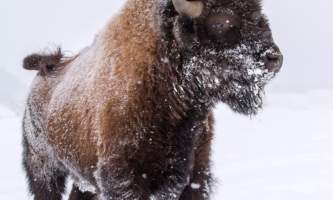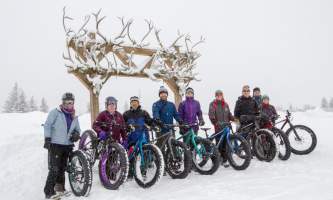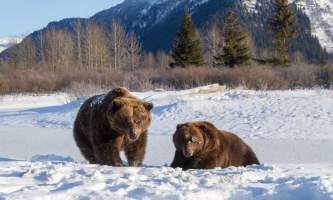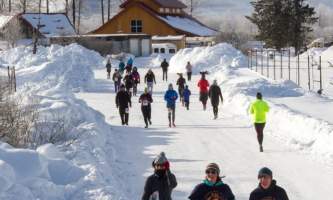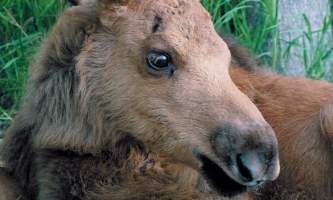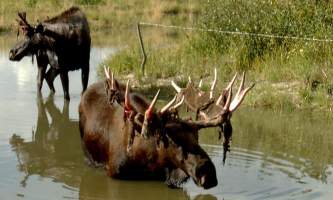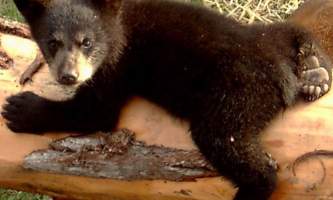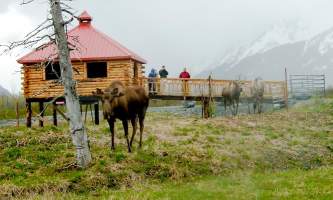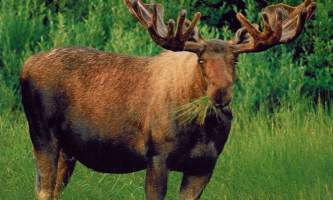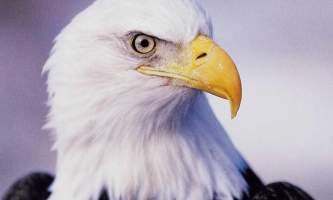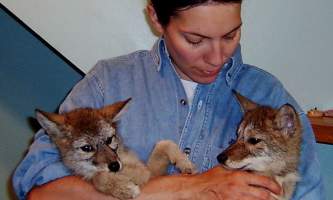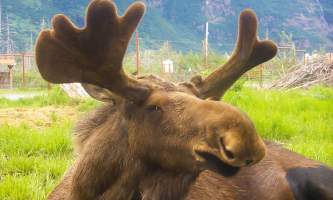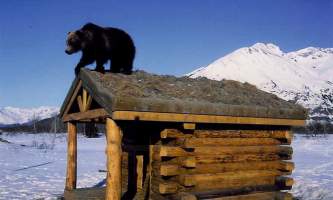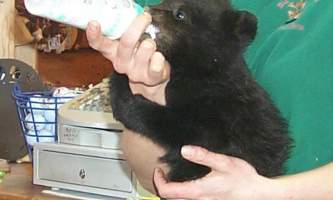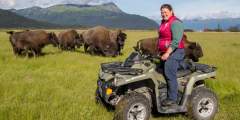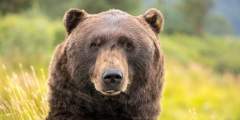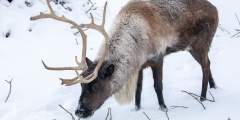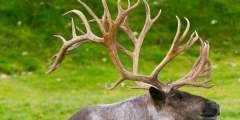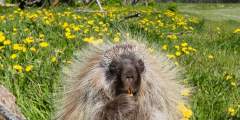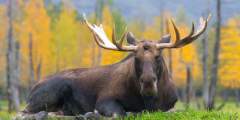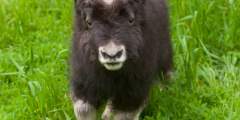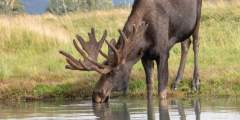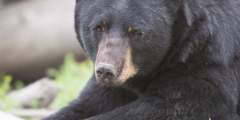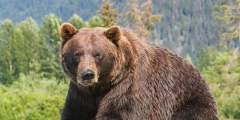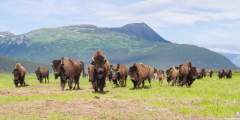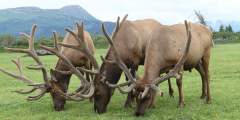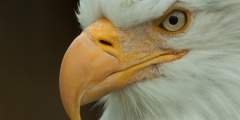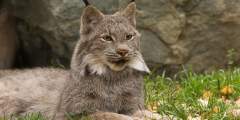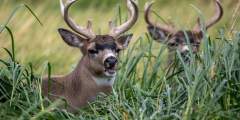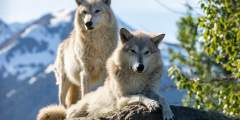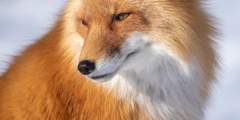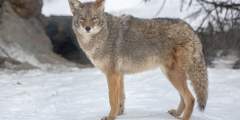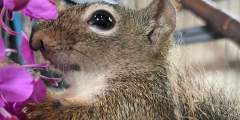At the 200-acre Alaska Wildlife Conservation Center, jaws drop in awe-even those of longtime Alaskans who've studied grizzlies and other animals up close. AWCC's mission is to preserve Alaska’s wildlife through conservation, research, education and quality animal care. The center, which opened to the public in 1993, also educates visitors about Alaska's wildlife. Coyotes peer out from behind the brush while a bald eagle swoops in on the salmon remains left by a grizzly bear. Wood Bison plod through 65 acres of tidal flat terrain, as part of a program that have restored the species to the Alaskan wilderness. Animals that cannot be released into the wild are given a permanent home at the center. Come be a part of these exciting programs and watch these animals display their natural, “wild”, behavior.
The Center's Setting
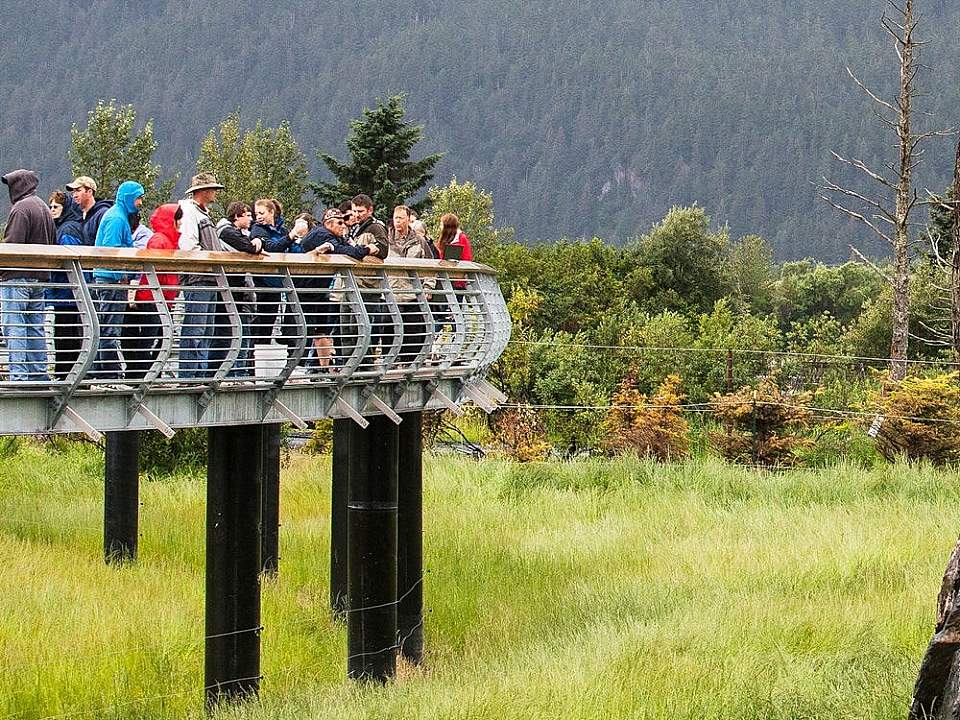
Animals that cannot be released into the wild are given a permanent home at the center
Set on the shores of Turnagain Arm, surrounded by mountains and hanging glaciers, the center is the perfect setting to learn about Alaskan wildlife. The animals are located in different areas grouped around several road loops. Perhaps the best way to view the facility is to first drive around to get your bearings, then park by the gift shop and walk. Each habitat area has a sign explaining the history and habits of the particular animals.
Stars of the Show
Hugo steals the show. She was found as a young grizzly bear by hunters near Kotzebue, in the northwest corner of the state. Orphaned and starving, she had almost 150 porcupine quills stuck in her paws and was unable to find food. The cub got a ride to Kotzebue on a snowmachine with the hunters, then a trip to Anchorage on an airplane. The Alaska Wildlife Conservation Center, formerly known as Big Game Alaska, cared for Hugo after she was brought to their facility. She was placed on antibiotics and fed a high-fat diet.
Now Hugo has matured, and while she will never be released into the wild, she struts around her spacious 20-acre, fenced-in habitat like the queen she is. Viewers can see her pigeon-toed walk up close-she passes just feet from the fence. She might even climb up to the roof of a small cabin to snack on a piece of salmon she finds there. Seeing a bear eating salmon on the roof of a cabin is quite a sight.
Winter Wildlife
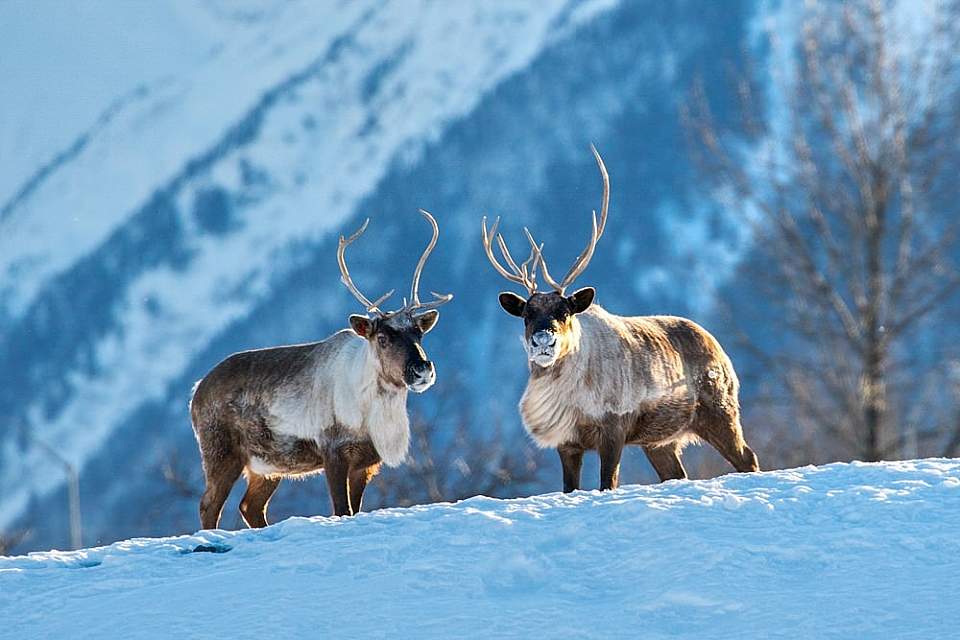
The center is open year-round with special discovery programs in winter
Come in the winter season (from October through April) for a different view of the wildlife, like the moose, wood bison, reindeer, wolves, deer, muskox and foxes (keep in mind, the black and brown bears keep a low profile this time of year, as they can be hibernating).
The 1.5 mile loop is your snowy playground! The weather and the roads at AWCC are perfect for kick-sled adventures, and the center has kick-sleds to fit all ages and sizes. Enjoy the great outdoors and have a blast with your family and friends as you kick-sled around the sanctuary and check out the animals. Other adventurous & unique ways to explore the Center while enjoying the wildlife include gliding on your cross country skis and riding your fat bike.
Or, sign up for one of the monthly Animal Enrichment workshops—where you can help create enrichment items (like toys) for our resident animals—and events like the Fat Bike ride in January and the Bison Run in April.
Guided Tours & Encounters
Year-Round
Walk on the Wild Side Tour (WOW) – 2PM Daily: Have a look at the inner – workings of the Alaska Wildlife Conservation Center! Enjoy this 90-minute tour where your naturalist guide walks you through the Center, offering history and stories of resident wildlife – and you’ll get to feed an animal! This tour offers the best opportunity to get up-close and personal with Alaska’s wildlife! Maximum of 10 persons per tour, for ages 10 and up.
Seasonal
Moose Encounter – 10:30AM Saturdays, Sundays, Tuesdays, & Thursdays: Get in touch with your wild side and stand face to face with one of Alaska’s most iconic animals, the North American Moose. This amazing, one-of-a-kind experience allows you the opportunity to meet AWCC’s resident moose and learn all about their amazing adaptations for survival. For all ages. Maximum capacity of 35. June 1 - September 15, depending on weather and moose participation.
Bear Encounter - 3:45PM on Mondays, Wednesdays, & Fridays: Get an up-close and personal experience with AWCC’s resident brown bears this summer! Participate in their daily training and feeding all while learning about bear behavior and diet. As we do not feed the Brown Bears their regular diet in the public view, this is a very exclusive tour. 30 minutes. Ages 12 and older. Space is limited to 10 people. Disclosure: During this encounter there is no physical touching of the bears. June 1 - August 15.
Hours
Operating Hours, Open Rain or Shine:
- February 2023: 10AM to 5PM, last entry at 4PM (4-day operations: Friday, Saturday, Sunday and Monday)
- March & April 2023: 10AM to 6PM, last entry at 5PM (Open 7 days per week)
- May, June, July, August 2023: 9AM to 7PM, last entry at 6PM (Open 7 days per week)
- September 1 - 15, 2023: 9AM to 6PM, last entry at 5PM (Open 7 days per week)
- September 16 - October 31, 2023: 10AM to 6PM, last entry at 5PM (Open 7 days per week)
- November 2023: 10 AM to 5PM, last entry at 4PM (4-day operations: Friday, Saturday, Sunday and Monday)
- December 2023: 10AM to 4PM, last entry at 3PM (4-day operations: Friday, Saturday, Sunday and Monday)
- January 2024: 10AM to 4PM, last entry at 3PM (4-day operations: Friday, Saturday, Sunday and Monday)
- CLOSED: Thanksgiving, Christmas Eve, Christmas Day and New Year’s Day. Open all other holidays.
Note: Hours are subject to change without notice due to unforeseen circumstances.
Free Daily Educational Programs. Click here for current offerings.
What to Bring
- Good walking shoes.
- Dress in layers.
- Camera and binoculars.
Getting There
Portage, AK 99587
By Car: Follow the highway south out of Anchorage, continuing 11 miles past the Girdwood turnoff. The center will be on the right, with a well-marked sign, just after a train station on the left. Location is 45 miles south of Anchorage on the New Seward Highway.
Prices & Dates
| Season | Year Round |
| Rates | Admission // $25 general (13+), $20 youth (4 - 12), children 3 & under are free // $22 Active Military (with ID), $22 Alaska Resident (with ID) |
| Walk on the Wild Side Tours // $125 per person // 90 mins | 2pm daily year-round | Ages 10 and over | Reservations required | |
| Moose Encounter // $25 per person | 10:30am Sat, Sun, Tue, Thur | Jun 1 - Sep 15 (weather dependent) | All ages | |
| Bear Encounter // $125 per person | 3:45pm Mon, Wed, Fri | Jun 1 - Aug 15 | Ages 12+ |
Show Map
Alaska Wildlife Conservation Center Guide
Now it’s time to go over some basics. Fortunately, we do have rules to abide by.. but hear me out!
In Alaska it’s not just bears you need to worry about. Aside from the weather and realities of how unforgiving the climate can be (did you bring rain gear?), we live among bears and other large animals like moose.
Black Bears are one of the more adaptable animals in the entire animal kingdom, as they are currently found in every single United States’ state, with the exception of Hawaii.
Despite having a brown bear in the state of Alaska, we actually have three sub-species; Grizzly Brown Bears, Coastal Brown Bears, and the Kodiak Brown Bear.
The Wood Bison at the Wildlife Conservation Center are currently the only herd in the United States
Sitka black-tailed deer are a diminutive coastal subspecies of the mule deer that is common throughout western North America.


